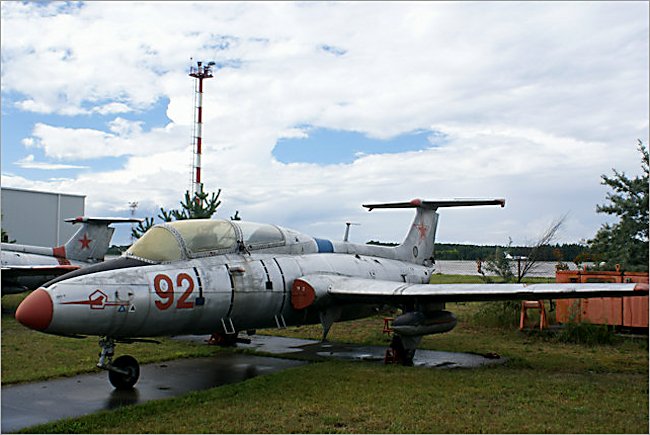Aero L-29 Delfin Dolphin Jet Trainer
The Aero L-29 Delfin Dolphin Maya Soviet Jet Trainer had a maximum speed of 820 km/h (442 knots, 510 mph). It had a range of 894 km (480 nmi, 555 mi) with tip tanks. Although it was a jet trainer it carried the following armament 200 kg (440 lb) of various guns, bombs, rockets, and missiles on external hardpoints. They were used for weapon training. It was given the name Maya by NATO as a code reporting name. The official name Delfin translates into Dolphin. It became the standard jet trainer for the air forces Warsaw Pact nations in the 1960s. It is believed about 3,500 were built and there are around 50 that are still airworthy.
In the late 1950s, the Soviet Air Force was seeking a jet-powered replacement for its fleet of piston-engined trainers, and this requirement was soon broadened to finding a trainer aircraft that could be adopted in common by Eastern Bloc air forces. Aero's response, the prototype XL-29 designed by Z. Rublic and K. Tomas first flew on 5 April 1959, powered by a British Bristol Siddeley Viper engine. The second prototype was powered by the Czech-designed M701 engine, which was used in all subsequent aircraft.

Photograph taken at the Russian Aircraft Museum next to Riga International Airport Latvia
The basic design concept was to produce a straightforward, easy-to-build and operate aircraft. Simplicity and ruggedness were stressed with manual flight controls, large flaps and the incorporation of perforated airbrakes on the fuselage sides providing stable and docile flight characteristics, leading to an enviable safety record for the type. The sturdy L-29 was able to operate from grass, sand or unprepared fields. Both student pilot and instructor had ejection seats, and were positioned in tandem, under separate canopies with a slightly raised instructor position.
In 1961, the L-29 was evaluated against the PZL TS-11 Iskra and Yakovlev Yak-30 and emerged the winner. Poland chose to pursue the development of the TS-11 Iskra anyway, but all other Warsaw Pact countries adopted the Delfin under the agreements of COMECON.

Photograph taken at the Russian Aircraft Museum next to Riga International Airport Latvia
The Delfin served in basic, intermediate and weapons training roles. For this latter mission, they were equipped with hardpoints to carry gunpods, bombs or rockets, and thus armed, Egyptian L-29s were sent into combat against Israeli tanks during the Yom Kippur War. The L-29 was supplanted in the inventory of many of its operators by the Aero L-39 Albatros. More than 2,000 L-29s were supplied to the Soviet Air Force, acquiring the NATO reporting name "Maya."
On July 16th, 1975, a Czechoslovakian Air Force L-29 shot down a Polish civilian biplane piloted by Dionizy Bielański that was attempting to defect to the West. Russia says it destroyed 2 Georgian L-29s during the 2008 South Ossetia war.